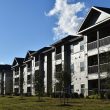Report: Land use policies can reduce carbon emissions
As communities across the United States face an ongoing housing crisis, thoughtful land use policies make sense. Research from Urban Institute recently correlated relaxed zoning with increased “market rate” housing supply. But that’s not the only reason why American cities and counties are reconsidering their regulations—they can also cut down on a community’s carbon emissions.
Urban landscapes across the United States were designed around single-family homes and motor vehicles. Residents must drive to access basic necessities like groceries, or go to work and school. Because of this, transportation is the leading carbon-emitting sector in the nation, according to the new report “Urban Land Use Reform: The Missing Key to Climate Action Strategies for Lowering Emissions, Increasing Housing Supply, and Conserving Land,” published by the advocacy organization Rocky Mountain Institute (RMI).
“These policies have led to a chronic housing shortage, numerous harms for disadvantaged communities, and sprawling development patterns that exacerbate climate change and ecological harm,” reads a statement from RMI about the findings. While land use policies are often cited by researchers as effective means to increase housing supply, the report highlights that they’re not often referenced in relation to climate change mitigation, even though there’s an intrinsic relationship between suburban design and reliance on motor vehicles.
The land use policies report estimates that 70% to 90% of residential zoning in U.S. cities house single-family detached homes. Along with the increased energy needs of detached houses when compared to apartments or multi-family dwellings, the physical infrastructure and utilities required to support suburban dwellings are a drain on resources. Features like cul-de-sacs and street networks that funnel even short trips onto highways are “fundamentally at odds with compact and walkable neighborhoods, and it makes efficient and cost-effective public transportation challenging,” reads the report. The researchers call for consideration of “wholesale suburban retrofits.”
Retrofits could include the build-out of suburban centers. Cul-de-sacs could be connected with pathways, and neighborhoods could be infilled to improve walkability and reduce the need for travel. Bicycle and pedestrian infrastructure could be improved. Other suggestions noted in the report include converting general roadway lanes into express bus lanes and changing land use regulation.
Changes include increasing height limitations, minimum lot size, expanding parking requirements, and modifying setbacks and floor-to-area ratio requirements, among other things. Policy changes like these would encourage developers to build housing and amenities closer together. It would also reduce energy usage because more people would be living in one envelope, and it would curb urban sprawl, saving open space to be used for other necessary functions like farming, conservation and carbon sequestration.
In an analysis of three of the nation’s fastest-growing metropolitan areas—Austin, Tx., Charlotte, N.C., and Denver, Colo.—researchers found that land use reforms in those cities could reduce vehicle miles traveled by about 13%, cut down on building energy usage by 16%, and cut local greenhouse gas emissions by 14% (averaged across the three ares).
“Cities, regions, and states have great potential to reduce or avoid emissions over the next two decades through land use reform. This will be no small challenge, given the various policy reforms that need to be enacted to overcome the many barriers to more efficient land use,” the report says. “By building broad coalitions—including affordable housing and tenant advocates, real estate developers, environmental nonprofits, local community-based organizations, and others—in a concentrated endeavor to improve the status quo, it is possible.”




















